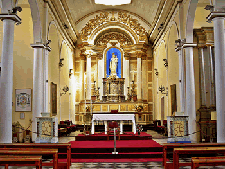Cathedral of Copiapo
The Copiapo Cathedral in Copiapo, Chile was
constructed between 1840 and 1851 in a neoclassical style by William
Rogers and replaced the original church that had been built in 1748.
This lovely church has a wide entrance crowned by a square tower
with three levels that are encompassed by slender columns, which is
considered quiet unique in this southernmost country. It is still an
active church with services being held on Saturdays and Sundays; but
can be toured anytime during the week. The city had remained
undeveloped until the early 18th century when gold was discovered
and began the incredible growth of the city, its economy and the
people that would come here for jobs and hopes of becoming rich,
much like the miners of 1849 when they headed to California or the
later gold rush to Alaska. It was governor of the colony, Jose Manso
de Velasco, that realized in 1744, that the region would need
workers and other immigrants to work the new mines for gold and
other materials, so he would incorporate the new town, and put a
square in it to contain a church and other important businesses to
bring more people here and materials. The church was constructed a
half block to the west of the square, later called the Plaza de
Armas. Once the Jesuit priests had constructed living quarters for
themselves, they would begin the construction of the church and the
cemetery adjacent it, using the finest masons available, with the
work starting in 1748. By 1750 the church was finished, but would
not open its doors until 1766, as the local community began to feel
the effects of miners and others coming here for adventure and
riches. The church was destroyed in 1796 when an earthquake
devastated the region, with the new cathedral being constructed
starting in 1840, and by 1849, only the roof would be unfinished.
Using the French architect, Jean Herbage, they learned that he would
recommend against using adobe to construct the church because of the
instability of it when the earthquakes hit. They would contract an
Englishman named William Rogers who brought 15 carpenters with him
to build it out of wood that would be able to "bounce" when the
quakes hit and not destroy the structure as well. The church would
acquire the neoclassical designs from him, with fir beams and
pillars that were brought from the United States via ships, along
with oak. The interior of the cathedral has a magnificent silver
shrine and wooden altar that was decorated with neoclassical details
by Italian artist G. Fiorani.
|

